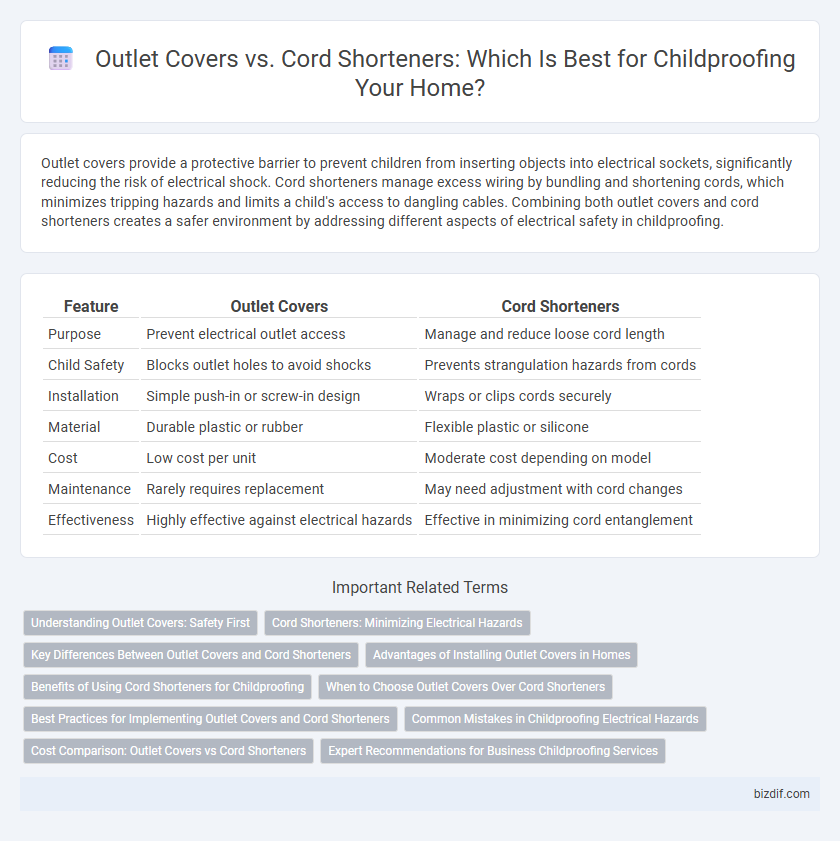Outlet covers provide a protective barrier to prevent children from inserting objects into electrical sockets, significantly reducing the risk of electrical shock. Cord shorteners manage excess wiring by bundling and shortening cords, which minimizes tripping hazards and limits a child's access to dangling cables. Combining both outlet covers and cord shorteners creates a safer environment by addressing different aspects of electrical safety in childproofing.
Table of Comparison
| Feature | Outlet Covers | Cord Shorteners |
|---|---|---|
| Purpose | Prevent electrical outlet access | Manage and reduce loose cord length |
| Child Safety | Blocks outlet holes to avoid shocks | Prevents strangulation hazards from cords |
| Installation | Simple push-in or screw-in design | Wraps or clips cords securely |
| Material | Durable plastic or rubber | Flexible plastic or silicone |
| Cost | Low cost per unit | Moderate cost depending on model |
| Maintenance | Rarely requires replacement | May need adjustment with cord changes |
| Effectiveness | Highly effective against electrical hazards | Effective in minimizing cord entanglement |
Understanding Outlet Covers: Safety First
Outlet covers are essential safety devices designed to prevent children from inserting objects into electrical outlets, reducing the risk of electrical shocks and injuries. These covers come in various forms, including plug-in caps and sliding plates, each providing a secure barrier while maintaining outlet functionality for adults. Prioritizing outlet covers in childproofing strategies ensures a fundamental layer of protection against electrical hazards in the home environment.
Cord Shorteners: Minimizing Electrical Hazards
Cord shorteners reduce electrical hazards by eliminating excess cable length, preventing children from pulling or tripping over dangling cords. Unlike outlet covers that block access to sockets, cord shorteners manage wire clutter and reduce the risk of electrical shocks and strangulation. Effective use of cord shorteners in childproofing creates a safer environment by controlling cord accessibility and minimizing potential dangers.
Key Differences Between Outlet Covers and Cord Shorteners
Outlet covers and cord shorteners serve distinct functions in childproofing electrical safety; outlet covers prevent direct contact with electrical sockets, reducing the risk of electric shock, while cord shorteners organize and secure excess cord length to prevent tripping hazards and chewing by children. Outlet covers are typically made of durable plastic and fit snugly into outlets, blocking access, whereas cord shorteners use clips or wraps to bundle cables and keep them out of reach. Choosing between these tools depends on specific household risks--outlet covers address socket exposure, while cord shorteners manage cable-related dangers.
Advantages of Installing Outlet Covers in Homes
Installing outlet covers provides an essential layer of protection by physically blocking access to electrical sockets, reducing the risk of electrical shock and injury in homes with young children. Outlet covers are easy to install, maintain, and replace, ensuring consistent safety without altering the appearance or function of outlets. Unlike cord shorteners, outlet covers do not interfere with cord length or device usage, making them a practical and effective childproofing solution for households.
Benefits of Using Cord Shorteners for Childproofing
Cord shorteners reduce the risk of electrical hazards by keeping cords out of children's reach, minimizing tripping and strangulation dangers. Unlike outlet covers, which only prevent direct socket access, cord shorteners effectively manage loose cables to create a safer environment. This solution enhances home safety by organizing and securing cords, crucial for comprehensive childproofing.
When to Choose Outlet Covers Over Cord Shorteners
Outlet covers are essential when preventing direct access to electrical sockets, significantly reducing the risk of electric shock for toddlers who tend to insert objects into outlets. Choose outlet covers over cord shorteners in homes where children frequently explore outlets or where multiple exposed sockets present a hazard. Cord shorteners primarily manage cable length and reduce tripping but do not block access to the electrical source, making outlet covers a more effective childproofing solution for securing electrical outlets.
Best Practices for Implementing Outlet Covers and Cord Shorteners
To maximize child safety, install outlet covers that fit securely and are made from durable, non-toxic materials to prevent accidental electrical shocks. Complement outlet protection by using cord shorteners to keep electrical cords out of reach, reducing tripping hazards and deterring children from pulling on cords. Regularly inspect both outlet covers and cord shorteners for wear and replace them promptly to maintain optimal safety in your home.
Common Mistakes in Childproofing Electrical Hazards
Outlet covers and cord shorteners are essential tools for childproofing electrical hazards but are often misused, reducing their effectiveness. Common mistakes include relying solely on outlet covers without securing cords, which remain a strangulation and chewing risk, and using cord shorteners that don't fully conceal cables or leave gaps where children can access plugs. Proper childproofing means combining securely fitted outlet covers with well-managed, hidden cords to minimize electrical injury risks.
Cost Comparison: Outlet Covers vs Cord Shorteners
Outlet covers typically range from $5 to $15 for a pack, making them an affordable childproofing solution for electrical outlets. Cord shorteners average between $10 and $25 depending on material and design, often providing a more versatile option for managing cords and reducing tripping hazards. Comparing costs, outlet covers offer a budget-friendly choice for basic outlet protection, while cord shorteners invest slightly more to enhance overall cable safety.
Expert Recommendations for Business Childproofing Services
Expert recommendations for business childproofing services emphasize the combined use of outlet covers and cord shorteners to enhance electrical safety. Outlet covers prevent children from inserting objects into sockets, reducing the risk of electric shock, while cord shorteners manage excess cable length, minimizing tripping hazards and potential strangulation risks. Utilizing both devices creates a comprehensive approach to electrical hazard mitigation in child-sensitive environments.
Outlet Covers vs Cord Shorteners Infographic

 bizdif.com
bizdif.com